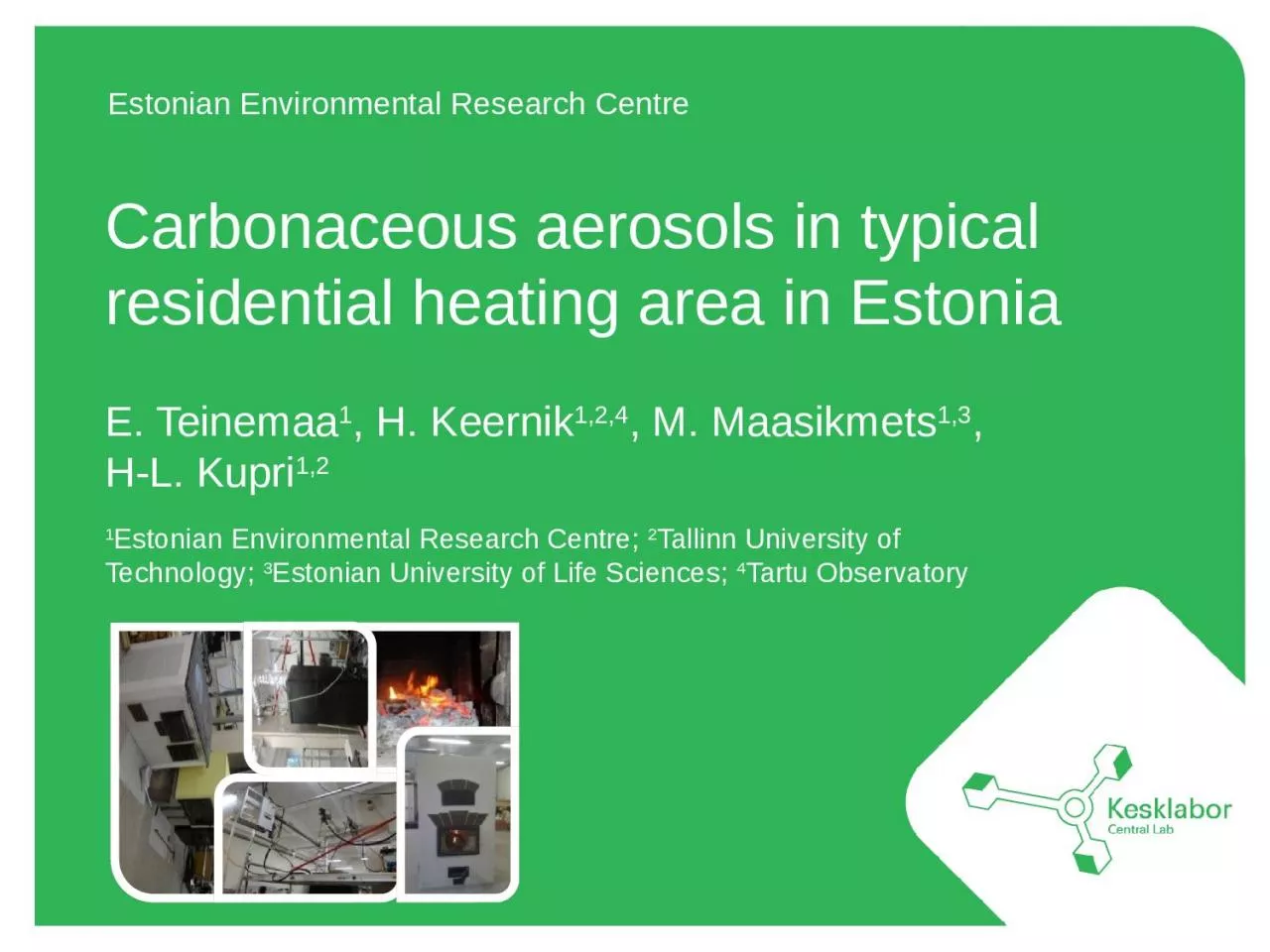

E Teinemaa 1 H Keernik 1 2 4 M Maasikmets 1 3 HL Kupri 1 2 1 Estonian Environmental Research Centre 2 Tallinn University of Technology 3 Estonian University of Life Sciences ID: 1040076
Download Presentation The PPT/PDF document "Carbonaceous aerosols in typical residen..." is the property of its rightful owner. Permission is granted to download and print the materials on this web site for personal, non-commercial use only, and to display it on your personal computer provided you do not modify the materials and that you retain all copyright notices contained in the materials. By downloading content from our website, you accept the terms of this agreement.
1. Carbonaceous aerosols in typical residential heating area in EstoniaE. Teinemaa1, H. Keernik1,2,4, M. Maasikmets1,3, H-L. Kupri1,21Estonian Environmental Research Centre; 2Tallinn University of Technology; 3Estonian University of Life Sciences; 4Tartu Observatory
2. IntroductionIn Tartu (2nd largest city in Estonia) the annual level of B(a)P have been exceeding target value 1 ng/m3Tartu has residential heating areas typical for Estonian townsWood logs and wood chips account >90% of the fuel used for residential heating2
3. Four measurement campaigns in typical residential areas in Tartu has been carried out using mobile stations
4. MeasurementsFilter analysisEC/OC (Sunset lab)BC (Magee SootScan OT21)Heavy metals - Al, As, Sb, Cd, Co, Cr, Mn, Mo, Ni, Pb,Se, V, Fe, Zn, Cu (ICP-MS)PAH - acenaphthene, acenaphthylene, anthracene, fluoranthene, fluorene, naphthalene, phenanthrene, pyrene, benz[a]anthracene, benzo[b]fluoranthene, benzo[k]fluoranthene, benzo[ghi]perylene, benzo[a]pyrene, chrysene, dibenz[a,h]anthracene, and indeno[1,2,3-cd]pyrene (GC-MS)Levoglucosan (GC-MS)Terephtalic acidStationary stationBC (ethalometer AE33)ACSM (Aerodyne)EC/OC (Field Sunset)PM10 sampling Digitel DHA-90PM10/PM2.5 with BAM 1020CO, NOx, SO2, O3Ambient air measurements with mobile stationsBC (ethalometer AE33)PM10 sampling Digitel DHA-90Heavy metals, PAHsPM10/PM2.5 with BAM 1020CO, NOx, SO2, O34
5. Carbonaceous fractionDuring 2018 heating season BC contributes about 20% of the PM2.5 massEC/OC contributes about 45% ofPM2.5 massDuring all periods and using differentmethods this value varies
6. EC/OC and BCComparison between Sunlab EC/OC and Magee aethalometer BC valuesStrong correlation between both EC and OC with BCFor 2018 winter in Tartu station:EC vs BC 0.944OC vs BC 0.918
7. Sootscan OT21Magee Sootscan OT21 was used to analyse filter samplesThe correlation with online aethalometer BC was good, the problem was with high BC levels (issue with high-vol samplers, should not be issue with low-volume sampler filters) Pearson 0.768Pearson 0.700
8. LevoglucosanGood correlation between levoglucosan and BCwb with BaPTartu station 2018 winterBaP vs levoglucosan 0.804BaP vs BCwb 0.866Levoglucosan vs BCwb 0.918Mobile station 2018 winterBaP vs levoglucosan 0.543BaP vs BCwb 0.858Levoglucosan vs BCwb 0.824
9. PAHs
10. Residential emissionsData from construction register (heated area and heating system) and cadastral registry (coordinates) was used to compile emission databasePM2.5, BC and BaP emissions (g/s) were calculated for each household based on energy consumption and emission factors from earlier laboratory studies (Maasikmets et al. 2016, Teinemaa et al. 2013)Emission measurements did not encompass condensables10
11. Dispersion modellingDiurnal and monthly variation of the emissions was based on measured BCwb results – both for PM2.5 and BaP emission databasesDispersion modelling was used to calculate levels of PM2.5, BC and BaP using ensemble of two different dispersion models in Airviro modelling environment (SMHI Gauss, SMHI Grid). The dispersion modelling results were compared against BCwb measurements in stationary and mobile stationsThe average concentrations were in good agreement, which was not case for hourly variation – activity data is issueTartu station2017Tartu station201611
12. Activity dataIssues with correct activity dataSimple time variationHeating days based on ambient temperatureVariation based on ambient BCwb levelsTemperature sensors in chimneys
13. Modelled BaP levelsBased on PM2.5 and BCwb emission measurements the BaP emission database was compilated and used to model ambient BaP levelsGas-phase BaP attributes approximately 7-9% of the total BaP2017 dataBCwb and BaPCorrelation R2January0.93February0.90March0.94April0.75May0.75June0.73July0.56August0.81September0.80October0.99November0.98December0.88
14. ConclusionsElevated levels B(a)P are mainly related to the local emissions from the residential heating in TartuCity draw action plan to reduce BaP levels and which was publicized last monthEthalometer BCwb can be used to predict BaP and PAH concentration in residential areasVery good correlation between PAH’s, PM2.5, PM10 and BC, EC/OC and levoglucosan concentrationsBaP emission database compiled for Tartu and modelling (hourly) was validated through BCwb online measurements
15. Ongoing activitiesTime variation for the residential heatingTemperature probes are installed to chimneys in Tartu to register actual heating timesEmission factors for condensable PM – current national emission factors don’t include condensable fractionWhat to do with positive gaseous artefact in EC/OC analysis in OC partshould it be deducted from total OC?Compiling BCwb and BaP emission databases for other Estonian towns with residential heating
16. Thank you for your attention!